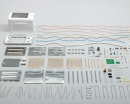The Five Lenses are five equally important diverse perspectives focussed on problem solving and ideas generation for a multifarious perspective. The lenses are derived from architectural and design thinking, the theory of multiple intelligences, Lean and disruptive thinking. The lenses address neuroplasticity, specifically that the brain defaults to its expert neural pathways unless provoked otherwise.
Each Lens provokes a distinct and extreme point of view in a simple, comprehensible framework. Used as a set the Lenses pluralize an existing product, system or environment to reveal its multiple meanings, and work as tools to push individuals and teams outside their "expert" neural pathways for more diverse ideas and solutions. Each Lens can be used to diffuse and proliferate thinking at ideation stages, and to focus thinking where convergence is needed.
The Five Lenses enable groups and individuals to prolifically and quickly uncover options that can improve everyday processes as well as one- off issues.
The Five Lenses for ADVENTUROUS THINKING ARE:
1. Negative SpaceNegative Space is what is NOT. Negative Space is that physical, emotional and longitudinal amorphousness that is NOT the focus or the subject, but the physical, durational and perceptional context in which it exists.
|
2. Thinking SidewaysThinking Sideways is an extension of Empathetic Thinking and builds awareness of how our personal preferences dictate the way we interact with others – work colleagues and customers. Sideways Thinking is valuable for understanding how your personal tendencies might be compromising your decision-making and interactions.
|
3. Thinking BackwardsThinking Backwards uses Life Cycle Analysis information to consider where a project or product ends, and how the elements and functions that make up a product, system or campaign can be improved for a more precise, economical, robust result.
|
4. ReThinkingReThinking involves rediscovering and exploiting your core values. ReThinking is an extremely lens for reconsidering a product, business or strategy using internal expertise as a resource and the tools to pivot and proliferate.
|
5. ParkourParkour thinking is the most risk-positive thinking strategy . When successful it results in an improbable innovation leap. Otherwise it sheds new understanding and meaning on wicked problems and every day scenarios. Parkour does NOT require a problem: this disruptive thinking is best applied to products, issues and scenarios that are "just fine".
|
“I like nonsense, it wakes up the brain cells.....
...looking at life through the wrong end of a telescope is what I do”
DR SEUSS
...looking at life through the wrong end of a telescope is what I do”
DR SEUSS





